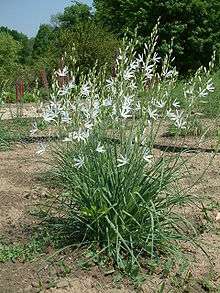Anthericum liliago
Anthericum liliago (St Bernard's lily) is a species of the genus Anthericum in the family Asparagaceae. It is native to mainland Europe (not the British Isles) and Turkey, growing in dry pastures, stony places and open woods and flowering in early summer. In Sweden the northernmost stable populations grows along the rocky shores of Lake Sommen (58° N), albeit on occasions it has been found as far north as Uppland (60° N).[1][2]
| Anthericum liliago | |
|---|---|
 | |
| Scientific classification | |
| Kingdom: | Plantae |
| Clade: | Tracheophytes |
| Clade: | Angiosperms |
| Clade: | Monocots |
| Order: | Asparagales |
| Family: | Asparagaceae |
| Subfamily: | Agavoideae |
| Genus: | Anthericum |
| Species: | A. liliago |
| Binomial name | |
| Anthericum liliago | |

Etymology
The specific epithet liliago means lily-like or lily-carrier. Like many plants whose common names include "lily", it is not closely related to the true lilies.
Description
It is a vigorous herbaceous flowering perennial with tuberous roots, 60–90 cm (2.0–3.0 ft) high, with leaves narrowly linear, 12–40 cm (4.7–15.7 in). and producing racemes of 6-10 lily-like white flowers in Spring and Summer.
Cultivation
Best grown in well-drained soil in a sunny position, A. liliago can be propagated by seed or by division of the rootstock every 3 to 4 years. It is a slow starter but forms large clumps with time (USDA Zone 6). The cultivar ‘Major’ has gained the Royal Horticultural Society’s Award of Garden Merit.[3]
References
- "Anthericum liliago Stor sandlilja". Artdatabanken (in Swedish). Swedish University of Agricultural Sciences. Retrieved May 2, 2019.
- "Om naturum". sommen-naturum.se (in Swedish). Naturum Sommen. Retrieved April 20, 2019.
- "RHS Plantfinder - Anthericum liliago 'Major'". Royal Horticultural Society. Retrieved 12 January 2018.
| Wikimedia Commons has media related to Anthericum liliago. |